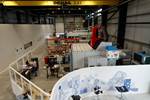Building a stronger longitudinal leaf spring
Benteler-SGL (Ried, Austria) has identified a carbon fiber hybrid system for production of longitudinal springs.
Benteler-SGL (Ried, Austria) has identified a carbon fiber hybrid system for production of longitudinal springs. “The longitudinal spring is wheel-guiding, so it is a security-related part, and a breakdown will lead to severe problems,” says Frank Fetscher, Benteler-SGL’s head of business development. “In order to have a much more robust part, we are developing an enhanced manufacturing process within composites in order to combine the advantages of filament winding, prepreg and RTM.”
The proprietary process is still in development. “We have achieved first milestones — first positive results — and we have a projected target,” says Fetscher. “We have achieved longitudinal leaf springs with the RTM process as well, but we are seeing physical demands increasing and, therefore, would like to have a second process on hand in order to be more flexible while maintaining the cost benefit of the RTM process.”
The longitudinal leaf springs are more exposed to impact from the outside than transverse springs. Because of this, glass fiber-reinforced polymer longitudinal leaf springs are not commonly employed. “There is a level of stiffness that is required in longitudinal leaf springs that is always independent of the width of the spring,” says Fetscher. “You need a flexible width and thickness variation in order to meet the demands of the level of stiffness combined with the main function — the hub stiffness,” he adds. “This is something we hope to achieve with the new process — more flexibility than even with RTM. Filament winding allows flexibility in the width of the spring, and RTM and prepreg allow for alternating thickness change.” Combining these processes and using carbon fiber, he says, could lead to a longitudinal leaf spring design applicable for light commercial trucks and pickup trucks.
This short article is a sidebar to a feature article titled "Composite leaf springs: Saving weight in production suspension systems." To read that article, click on its title under "Editor's Picks," at top right.
Related Content
-
Plant tour: Teijin Carbon America Inc., Greenwood, S.C., U.S.
In 2018, Teijin broke ground on a facility that is reportedly the largest capacity carbon fiber line currently in existence. The line has been fully functional for nearly two years and has plenty of room for expansion.
-
Infinite Composites: Type V tanks for space, hydrogen, automotive and more
After a decade of proving its linerless, weight-saving composite tanks with NASA and more than 30 aerospace companies, this CryoSphere pioneer is scaling for growth in commercial space and sustainable transportation on Earth.
-
Welding is not bonding
Discussion of the issues in our understanding of thermoplastic composite welded structures and certification of the latest materials and welding technologies for future airframes.




